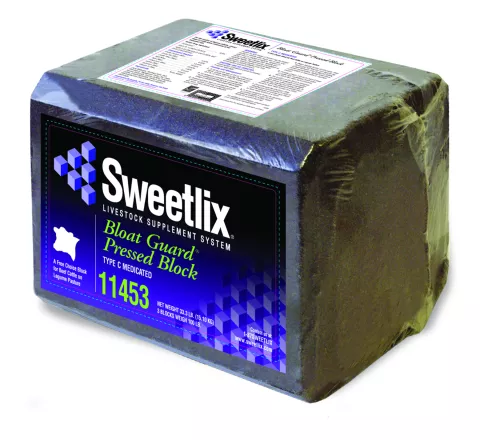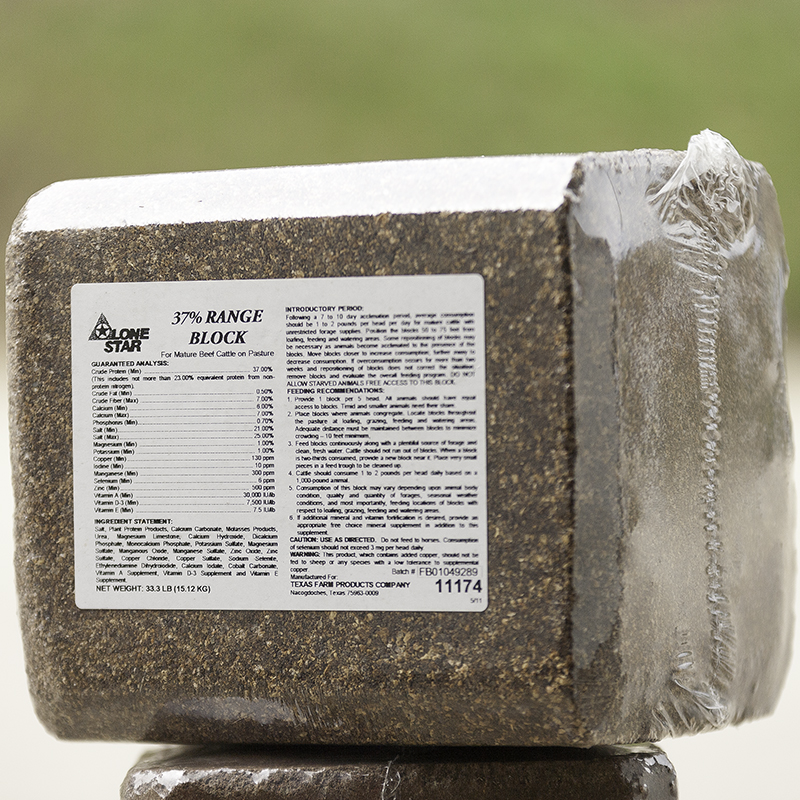
Bloat Guard Block
Product Number: 2188Type C Medicated - A free choice block for beef cattle on legume pasture.
Product Highlights
FEED TYPE
- Pressed Block
FEATURES
- Controls legume (alfalfa, clover) bloat in cattle
Ingredients
Cane Molasses, Soybean Hulls (Max 30%), Salt, Hydrogenated Soybean Oil, Ferrous Sulfate, Manganous Oxide, Manganese Sulfate, Zinc Oxide, Zinc Sulfate, Mineral Oil, Calcium Iodate, Cobalt Sulfate, Sodium Molybdate, Sodium Selenite, Ethylenediamine Dihydroiodide and Calcium Carbonate.
Active Drug Ingredient: Poloxalene* - 6.6% (Each lb. contains 29.94 g)
*With 0.03 Ethoxyquin and 0.095% BHT (both preservatives)
Feeding Directions
To be fed at the rate of 0.8 oz. of block per 100 lb. of body weight per day. Example: 8 oz. (0.5 lb.) of block for a 1000 lb. animal daily.
For adequate protection it is essential that each animal consume the total recommended dosage of SWEETLIX® Bloat Guard® Block daily.
Omit all salt from feed. Do not feed free choice sources of salt or mineral containing salt in any form. These blocks are an adequate source of salt.
Begin feeding blocks continuously. Feed blocks and full feed dry non-legume hay at least 48 hours prior to legume (alfalfa, clover) consumption. Repeat when block consumption is interrupted to maintain control.
Provide at least 1 block for each 5 head of cattle; add 1 additional block when each block has been half-consumed.
The location of the block is extremely important for adequate consumption. Place blocks where cattle congregate (watering, grazing and loafing areas) in order to limit the distance an animal must travel to have ready access to a block.
Controlled grazing practices (Strip Grazing) are recommended in order to limit the distance an animal must travel to have ready access to a block.
In some instances it may be necessary to confine cattle in a dry lot with additional Bloat Guard® Blocks for a period each day.
CAUTION: USE AS DIRECTED
Consumption of selenium should not exceed 3 mg per head daily. Access to, and intake of blocks may be limited during or directly after heavy rain or dew, and after frost or change of pasture. Variation in cattle routine may change their feeding and watering habits. Relocate blocks immediately as necessary. Special caution should be taken. Water high in salt and alkaline soils limit consumption and performance.
Additional Information
| Crude Protein (Min) | 4.00 | % |
| Crude Fat (Min) | 0.05 | % |
| Crude Fiber (Max) | 12.50 | % |
| Salt (Min) | 19.50 | % |
| Salt (Max) | 23.00 | % |
| Sodium (Max) | 10.00 | % |
| Potassium (Min) | 1.80 | % |
| Iodine (Min) | 43 | ppm |
| Selenium (Min) | 12.5 | ppm |
| Selenium (Max) | 13.5 | ppm |
Additional Information
| Crude Protein (Min) | 4.00 | % |
| Crude Fat (Min) | 0.05 | % |
| Crude Fiber (Max) | 12.50 | % |
| Salt (Min) | 19.50 | % |
| Salt (Max) | 23.00 | % |
| Sodium (Max) | 10.00 | % |
| Potassium (Min) | 1.80 | % |
| Iodine (Min) | 43 | ppm |
| Selenium (Min) | 12.5 | ppm |
| Selenium (Max) | 13.5 | ppm |
